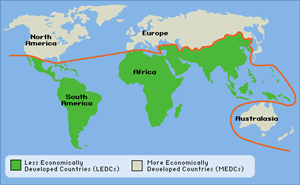Introduction
Every single day, 30,000 children are dying as a result of extreme poverty. That means over a thousand children will have died during one lesson – all the children at your school dying every hour, every day.
Problems in developing countries are complex, and one set of problems can lead to another in a ‘vicious circle’. Difficulties faced include:
AIDS |
Lack of education |
Poor sanitation |
Lack of development |
Flooding |
Unemployment |
Debt |
Trade restrictions |
Child labour |
Infant mortality |
Disease |
Malnutrition |
Illiteracy |
War |
Poor climate |
Slavery |
The North/South divide

If you get a map of the world, you can separate the poorer countries from the wealthier countries with a straight horizontal line. Apart from a few exceptions, such as Australia, this gives an accurate picture of where the wealth lies.
What is even more concerning than the statistics given in the table below is that things keep getting worse - the gap between the rich and the poor keeps growing.
The rich countries hold most of the power and make all of the rules about the world economy, finance and trade. The Make Poverty History campaign focussed on challenging the leaders of the most powerful countries to change the way they do things.
North |
South |
| Developed countries | Developing countries |
| 25% of the world’s population | 75% of world population |
| Use 4/5ths of the world’s resources, e.g. food and fuel | Use 1/5 of the world resources |
| 4/5th of world income | 1/5th of world income – most get less than £1.25 a week |
| Life expectancy – 70 years | Life expectancy – less than 50 years |
| 12 children out of 1000 die before age 5 | 100+ out of 1,000 die before age 5 |
| 94% of the world’s healthcare | 6% of the world’s health care |
| 470 people per doctor, 140 people per nurse | 14,000 people per doctor, 3,000 people per nurse |
| Easy access to medical care | Most (70%) never encounter medical care |
Water - 100% access to clean water. No droughts. |
Water - 70% get disease ridden, dirty water. 1 in 7 have serious droughts and water shortages |
| Food - virtually no hunger | Food - 1 billion people (20% world population) – not enough food |
| Malnutrition kills virtually nobody | Malnutrition causes 4 million childhood deaths per year; 40,000 people die every day of starvation, malnutrition, hunger and disease – most of which is preventable |
90% of children get secondary education |
10% of children get secondary education |
Absolute poverty
"Absolute poverty is a condition of life so characterised by malnutrition, illiteracy, disease, high infant mortality and low life expectancy as to be beneath any reasonable definition of human dignity."
Robert Macnamara
1 billion people, 1/5 of the world's population, live in absolute poverty. While we worry about dieting, 35,000 people starve to death every day. They will never realise their full potential. They are caught in a poverty trap of no schools, hospitals, employment, technology, transport or communications.
Many of the world's poorest countries in South America and Africa are caught in debt, environmental problems and overpopulation. The majority of people earn less than £100 a year (the average wage in the UK is £17,000). While you are reading this some 450 million people are starving to death
